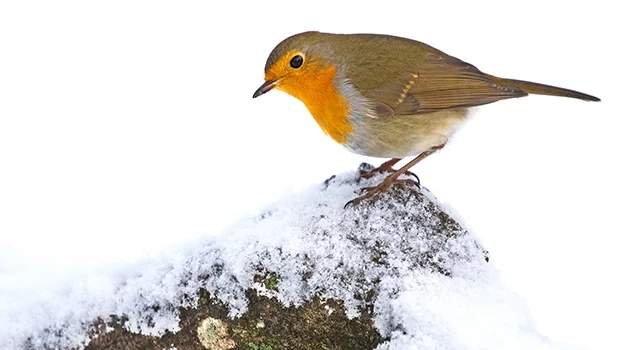In yet another casual refutation of the plaintive Creationist assertion that the Theory of Evolution (TOE) is about to be overthrown by their childish Bronze Age superstition, scientists from Uppsala and Gothenburg Universities, Sweden and Florida University, USA, have produced a family tree of the Old World flycatchers - a family of birds that includes the European Robin.
In doing so, they found not the slightest hint that the TOE is inadequate to explain the observations. In fact, as expected, it is entirely consistent with what they found.
As the article in Uppsala University news by Elin Bäckström explains:
The team have published their research, open access, in the journal Molecular Phylogenetics and Evolution:The European robin’s closest relatives are found in tropical Africa. The European robin is therefore not closely related to the Japanese robin, despite their close similarity in appearance. This is confirmed by a new study of the Old World flycatcher family, to which these birds belong. The study comprises 92 per cent of the more than 300 species in this family.The fact that the European and Japanese robins are so similar-looking despite not being closely related is one of many examples of so-called convergent evolution in this group of birds. Similarities in appearance can evolve in distant relatives, e.g., as a result of similarities in lifestyle.
Per Alström, corresponding author
Animal Ecology
Department of Ecology and Genetics
Evolutionary Biology Centre
Uppsala University, Norbyvägen, Uppsala, Sweden
The Old World flycatcher family comprises birds belonging to more than 300 species that are distributed across Europe, Asia and Africa. The family includes not only flycatchers, but also nightingales, chats, wheatears, redstarts, whistling-thrushes, forktails and other exotic groups. Twelve species breed in Sweden, of which the European robin, the pied flycatcher and the thrush nightingale are the most well-known. All except three of these species winter in sub-Saharan Africa or southern Asia.
Japanese robin, Larvivora akahige
The Japanese robin is not closely related to the European robin Erithacus rubecula.
Photograph: Craig BrelsfordResearchers from Uppsala University, the University of Gothenburg and the University of Florida have used DNA to reconstruct the family tree of 92 per cent of the species in the Old World flycatcher family. This study confirms previous findings regarding relationships as well as revealing new, unexpected relationships.Species that are named flycatchers are placed on many different branches in the family tree, and hence belong to groups that are not closely related. With respect to the Swedish flycatchers, the pied, collared and red-breasted flycatchers are closely related to each other, while the spotted flycatcher is a more distant relative. I never cease to be surprised by the many unexpected relationships that are revealed by DNA analyses.
Per Alström
Uppsala University has a long tradition of research on flycatchers, especially on pied and collared flycatchers. The present study supports the hypothesis that the bluethroat, which is colloquially called “the nightingale of the Swedish mountains”, has its closest relative in the Himalayas and the mountains of China.
Highlights
- A time-calibrated phylogeny of Muscicapidae covering all genera and 92% species.
- Incorporating molecular data gleaned from various public resources.
- Twenty-seven out of 34 polytypic genera are monophyletic.
- Taxonomic changes proposed for six genera that exhibit paraphyly or polyphyly.
Abstract
The Old World flycatchers, robins and chats (Aves, Muscicapidae) are a diverse songbird family with over three hundred species. Despite continuous efforts over the past two decades, there is still no comprehensive and well-resolved species-level phylogeny for Muscicapidae. Here we present a supermatrix phylogeny that includes all 50 currently recognized genera and ca. 92% of all the species, built using data from up to 15 mitochondrial and 13 nuclear loci. In addition to assembling nucleotide sequences available in public databases, we also extracted sequences from the genome assemblies and raw sequencing reads from GenBank and included a few unpublished sequences. Our analyses resolved the phylogenetic position for several previously unsampled taxa, for example, the Grand Comoro Flycatcher Humblotia flavirostris, the Collared Palm Thrush Cichladusa arquata, and the Taiwan Whistling-Thrush Myophonus insularis, etc. We also provide taxonomic recommendations for genera that exhibit paraphyly or polyphyly. Our results suggest that Muscicapidae diverged from Turdidae (thrushes and allies) in the early Miocene, and the most recent common ancestors for the four subfamilies (Muscicapinae, Niltavinae, Cossyphinae and Saxicolinae) all arose around the middle Miocene.
Zhao, Min; Gordon Burleigh, J.; Olsson, Urban; Alström, Per; Kimball, Rebecca T.
A near-complete and time-calibrated phylogeny of the Old World flycatchers, robins and chats (Aves, Muscicapidae)
Molecular Phylogenetics and Evolution; 178, 107646; DOI: 10.1016/j.ympev.2022.107646
Copyright: © 2022 The authors.
Published by Elsevier B.V. Open access
Reprinted under a Creative Commons Attribution 4.0 International license (CC BY 4.0)

Surprisingly, or perhaps not surprisingly given the Creationist propensity to ignore evidence which contradicts their superstition, evidence such as this won't deter the Creationist cult leaders from assertions about an impending collapse of the TOE as the explanation for biodiversity or pronouncements about an unproved supernatural entity's role in biology to fool even more child-like, scientifically illiterate simpletons into their lucrative anti-science cult.






No comments :
Post a Comment
Obscene, threatening or obnoxious messages, preaching, abuse and spam will be removed, as will anything by known Internet trolls and stalkers, by known sock-puppet accounts and anything not connected with the post,
A claim made without evidence can be dismissed without evidence. Remember: your opinion is not an established fact unless corroborated.